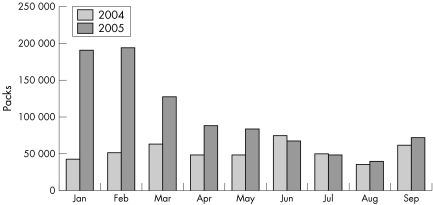From 10 January 2005, the Italian government enacted Law 3/20031 which bans smoking in all enclosed places, except those areas reserved for smokers and in private houses. The law permits the establishment of adequate rooms for smokers, and defines measures for controlling and sanctioning violations. The prohibition includes places open to the public, including all working places, shops, amusement and meeting places, and even common spaces (halls, stairs etc) in condominiums. It was expected that the introduction of such a law would initially present several obstacles connected both with its interpretation and implementation, and that the fear of economic damage to restaurant owners, tobacco shops and cigarette producers would generate opposition.
The Italian Ministry of Health initiated national awareness campaigns to strongly support the new law. A month before the law became effective, the Ministry of Health issued a notice interpreting and explaining the new law including a toll‐free number to answer citizens' questions and give information regarding the new legislation. Systematic random inspections were carried out by Special Corps in many public places and workplaces, including hospitals, clinics, banks, public offices, schools, restaurants, bars, discos, museums, and train stations.
During the period from January to November 2005, total sales of cigarettes (in kg) in Italy decreased by 5.7% (from 90 216 285.34 kg to 85 104 045.52 kg) in comparison with the same period in 2004. The adult per capita sales of cigarettes packs (20 cigarettes per pack) decreased from 94 packs in 2004 to 87.8 packs in 2005 (−6.6%). This reduction would appear to be associated with the impact of the law. There was a reduction of nearly 2.8% (in kg) in 2004 compared with 2003, and 1.3% (in kg) in 2003 compared with 2002, following health education campaigns and tobacco price rises.
From 1990 to 2002 the trend in cigarettes sales rose. (Source: Ministry of Economy, Autonomous Administration of Monopolies of State (AAMS)—AAMS is involved in the control of marketing of tobacco products in Italy, and in the measurement of tar, nicotine and carbon monoxide yields of cigarettes.)
From January to September 2005 total sales of nicotine replacement products increased by 10.8% (fig 1).
Figure 1 Nicotine replacement therapy sales in Italy, January–September 2004 and 2005. Source: Italian Medicines Agency (AIFA). AIFA is involved in pharmacovigilance and works autonomously under the direction of the Ministry of Health and in cooperation with the regional authorities, the National Institute of Health, research institutes, patients' associations, health professionals, learned societies and the pharmaceutical industry.
References
- 1.Anon Law January 16th, 2003, n. 3 “Ordinamental dispositions in public and administrative questions”; Official Gazette, 20 January 2003; 15 S.O. n 5.



